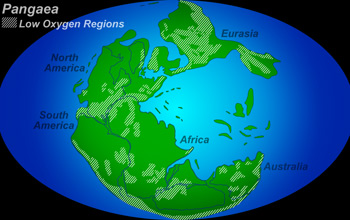News Release 05-058
Reduced Oxygen Contributed To “Great Dying”
Oxygen deficiency could also account for the delayed recovery of species diversity

The supercontinent Pangaea showing regions of low oxygen.
April 14, 2005
This material is available primarily for archival purposes. Telephone numbers or other contact information may be out of date; please see current contact information at media contacts.
New research suggests that low atmospheric oxygen levels had already increased extinction rates prior to the massive animal and plant extinctions 251 million years ago. Furthermore, reduced oxygen likely contributed to the protracted recovery from the catastrophic event.
Based on predicted oxygen levels in the late Permian and early Triassic periods--the timeframe spanning the great extinctions--Raymond Huey and Peter Ward at the University of Washington simulated on a computer the combined effects of reduced oxygen and topography on a set of hypothetical species representative of the period.
The scientists, whose work is supported by the National Science Foundation (NSF), published their findings in the April 15 issue of the journal Science.
As atmospheric oxygen decreased in the late Permian period, hypoxia, or insufficient oxygen in bodily tissue, would have become an undeniable problem for Earth's terrestrial species. Huey and Ward predicted that eventually, because oxygen levels decrease as altitude increases, only land near sea level would have been habitable on the relatively new supercontinent of Pangaea. As a result of this so-called "altitudinal compression," even modestly high mountains would have represented insurmountable barriers that prevented intermingling and reproduction between nearby populations.
These results could force paleontologists to re-evaluate the accepted notion that Pangaea was like a "superhighway" for species movement, as its mountain ranges may have impeded movement and drastically affected species development.
William Zamer, a manager in NSF's program for Integrative and Organismal Biology said, "Huey and Ward have produced a novel and insightful study linking the effects of a low-oxygen atmosphere with the possible biogeographic and evolutionary consequences on terrestrial animals during the Permian extinction."
For more details, see the University of Washington's news release.
-NSF-
-
A graph of atmospheric oxygen levels over time.
Credit and Larger Version
Media Contacts
Richard (Randy) Vines, NSF, (703) 292-7983, email: rvines@nsf.gov
Principal Investigators
Raymond Huey, University of Washington, (206) 543-1505, email: hueyrb@u.washington.edu
The U.S. National Science Foundation propels the nation forward by advancing fundamental research in all fields of science and engineering. NSF supports research and people by providing facilities, instruments and funding to support their ingenuity and sustain the U.S. as a global leader in research and innovation. With a fiscal year 2023 budget of $9.5 billion, NSF funds reach all 50 states through grants to nearly 2,000 colleges, universities and institutions. Each year, NSF receives more than 40,000 competitive proposals and makes about 11,000 new awards. Those awards include support for cooperative research with industry, Arctic and Antarctic research and operations, and U.S. participation in international scientific efforts.
Connect with us online
NSF website: nsf.gov
NSF News: nsf.gov/news
For News Media: nsf.gov/news/newsroom
Statistics: nsf.gov/statistics/
Awards database: nsf.gov/awardsearch/
Follow us on social
Twitter: twitter.com/NSF
Facebook: facebook.com/US.NSF
Instagram: instagram.com/nsfgov

